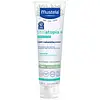What's inside
What's inside
 Key Ingredients
Key Ingredients

No key ingredients
 Benefits
Benefits

 Concerns
Concerns

 Ingredients Side-by-side
Ingredients Side-by-side

Zinc Oxide 14.9%
Cosmetic ColorantWater
Skin ConditioningOlea Europaea Fruit Oil
MaskingPropanediol
SolventRicinus Communis Seed Oil
MaskingBentonite
AbsorbentGlyceryl Rosinate
PerfumingCetearyl Alcohol
EmollientCalendula Officinalis Flower Extract
MaskingChamomilla Recutita Flower Extract
MaskingPersea Gratissima Fruit Extract
EmollientAloe Barbadensis Leaf Juice
Skin ConditioningButyrospermum Parkii Butter
Skin ConditioningHelianthus Annuus Seed Oil
EmollientOlea Europaea Oil Unsaponifiables
Skin ConditioningGlycerin
HumectantGlyceryl Oleate
EmollientCoco-Glucoside
CleansingMicrocrystalline Cellulose
AbsorbentCellulose Gum
Emulsion StabilisingCaprylhydroxamic Acid
Caprylyl Glycol
EmollientZinc Oxide 14.9%, Water, Olea Europaea Fruit Oil, Propanediol, Ricinus Communis Seed Oil, Bentonite, Glyceryl Rosinate, Cetearyl Alcohol, Calendula Officinalis Flower Extract, Chamomilla Recutita Flower Extract, Persea Gratissima Fruit Extract, Aloe Barbadensis Leaf Juice, Butyrospermum Parkii Butter, Helianthus Annuus Seed Oil, Olea Europaea Oil Unsaponifiables, Glycerin, Glyceryl Oleate, Coco-Glucoside, Microcrystalline Cellulose, Cellulose Gum, Caprylhydroxamic Acid, Caprylyl Glycol
Water
Skin ConditioningHelianthus Annuus Seed Oil
EmollientGlycerin
HumectantCaprylic/Capric Triglyceride
MaskingButyrospermum Parkii Butter
Skin ConditioningC10-18 Triglycerides
EmollientSucrose Stearate
EmollientHelianthus Annuus Seed Oil Unsaponifiables
EmollientPersea Gratissima Oil
Skin ConditioningAlpha-Glucan Oligosaccharide
CleansingBentonite
AbsorbentGlyceryl Caprylate
EmollientXanthan Gum
EmulsifyingSodium Benzoate
MaskingSodium Stearoyl Glutamate
CleansingCitric Acid
BufferingTocopherol
AntioxidantWater, Helianthus Annuus Seed Oil, Glycerin, Caprylic/Capric Triglyceride, Butyrospermum Parkii Butter, C10-18 Triglycerides, Sucrose Stearate, Helianthus Annuus Seed Oil Unsaponifiables, Persea Gratissima Oil, Alpha-Glucan Oligosaccharide, Bentonite, Glyceryl Caprylate, Xanthan Gum, Sodium Benzoate, Sodium Stearoyl Glutamate, Citric Acid, Tocopherol
Ingredients Explained
These ingredients are found in both products.
Ingredients higher up in an ingredient list are typically present in a larger amount.
Bentonite is an aluminium phyllosilicate clay with great absorbent properties. The name 'bentonite' comes from the area where the largest source is found: Fort Benton, Wyoming.
As a clay, bentonite is often used to absorb excess oil and provide exfoliation. It has also been shown to have some antibacterial and anti-inflammatory properties. Studies show bentonite was effective at calming dermatitis from poison ivy and in diaper dermatitis of infants. Bentonite has also been shown to act as a barrier against toxic compounds on your skin.
Sunscreens containing bentonite display higher water resistance and stay on the skin for much longer. The sunscreens containing bentonite also show higher potency and UV light absorbtion.
Bentonite is naturally created from volcanic ash and several natural weathering/hydrothermal processes.
A common usage of bentonite is removing excess protein from white wines. Bentonite contains a property of being able to absorb large amounts of protein from aqueous solutions.
Phyllosilicate clay has a structure formed by sheets.
Learn more about BentoniteThis ingredient is also known as shea butter. It is an effective skin hydrator and emollient.
Emollients help soothe and soften your skin. It does this by creating a protective film on your skin. This barrier helps trap moisture and keeps your skin hydrated. Emollients may be effective at treating dry or itchy skin.
Shea butter is rich in antioxidants. Antioxidants help fight free-radicals, or molecules that may harm the body. It is also full of fatty acids including stearic acid and linoleic acid. These acids help replenish the skin and keep skin moisturized.
While Shea Butter has an SPF rating of about 3-4, it is not a sunscreen replacement.
Shea butter may not be fungal acne safe. We recommend speaking with a professional if you have any concerns.
Learn more about Butyrospermum Parkii ButterGlycerin is already naturally found in your skin. It helps moisturize and protect your skin.
A study from 2016 found glycerin to be more effective as a humectant than AHAs and hyaluronic acid.
As a humectant, it helps the skin stay hydrated by pulling moisture to your skin. The low molecular weight of glycerin allows it to pull moisture into the deeper layers of your skin.
Hydrated skin improves your skin barrier; Your skin barrier helps protect against irritants and bacteria.
Glycerin has also been found to have antimicrobial and antiviral properties. Due to these properties, glycerin is often used in wound and burn treatments.
In cosmetics, glycerin is usually derived from plants such as soybean or palm. However, it can also be sourced from animals, such as tallow or animal fat.
This ingredient is organic, colorless, odorless, and non-toxic.
Glycerin is the name for this ingredient in American English. British English uses Glycerol/Glycerine.
Learn more about GlycerinHelianthus Annuus Seed Oil is the oil derived from the seeds of a Sunflower. Sunflower seed oil is non-fragrant. It is an emollient, meaning it helps to soften the skin.
Sunflower seed oil contains many fatty acids. The fatty acids found in sunflower seeds include (from highest amount to least): linoleic acid, myristic acid, palmitic acid, stearic acid, arachidic acid, oleic acid, and linolenic acid.
These fatty acids help the skin create ceramides. Ceramides play a role in repairing the skin barrier.
Helianthus Annuus Seed Oil helps moisturize the skin. This in turn helps the skin look more rejuvenated and smoother.
Sunflowers are rich in vitamin E.
Historians believe Indigenous cultures of North America domesticated sunflowers before corn. Thus they relied on sunflower oil for a variety of uses. One such use is moisturizing skin and hair.
Sunflower seed oil may not be fungal acne safe. We recommend speaking with a professional if you have any concerns.
Learn more about Helianthus Annuus Seed OilWater. It's the most common cosmetic ingredient of all. You'll usually see it at the top of ingredient lists, meaning that it makes up the largest part of the product.
So why is it so popular? Water most often acts as a solvent - this means that it helps dissolve other ingredients into the formulation.
You'll also recognize water as that liquid we all need to stay alive. If you see this, drink a glass of water. Stay hydrated!
Learn more about Water